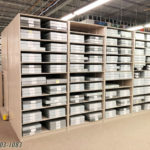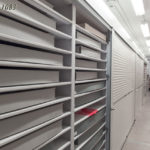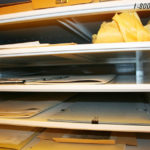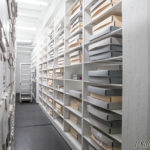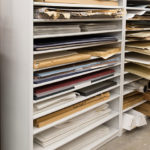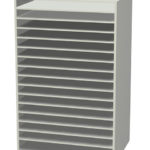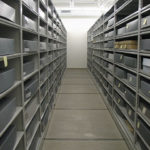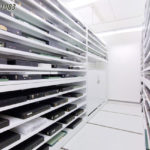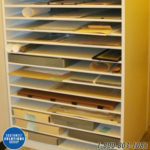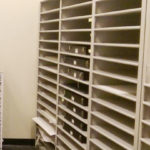Works on paper tend to be fragile and easily susceptible to damage and deterioration. Thus, great care must be taken when handling and storing these works. There are several requirements for optimal works on paper storage, including an appropriate storage environment and enclosures such as folders or Solander cases to protect individual works. Storage solutions such as works on paper shelving and flat file cabinets provide safe and efficient storage for long-term preservation.
Read on to learn about the best practices for storing works on paper and the different storage options available. You can also check out more of our museum storage solutions here.
Works on paper tend to be fragile and easily susceptible to damage and deterioration. Thus, great care must be taken when handling and storing these works. There are several requirements for optimal works on paper storage, including an appropriate storage environment and enclosures such as folders or Solander cases to protect individual works. Storage solutions such as works on paper shelving and flat file cabinets provide safe and efficient storage for long-term preservation.
Read on to learn about the best practices for storing works on paper and the different storage options available. You can also check out more of our museum storage solutions here.
Care and Storage of Works on Paper
The term “works on paper” typically refers to works of art on paper (such as drawings, paintings, and prints), documents, manuscripts, posters, maps, and other unbound paper materials. It’s best to store these works flat rather than folded or rolled to avoid damage. Depending on the size and type of work, works on paper may be stored in archival boxes, Solander cases, or flat file drawers.
Works on paper are sensitive to environmental factors such as humidity, temperature, and light. When storing works on paper, it is essential to ensure that these works are kept in a stable environment and adequately protected from light, dust, insects, and rodents. Visit our online store to see our museum storage products.
An appropriate storage environment for works on paper should adhere to the following recommendations:
- Clean and free of dust
- A cool temperature (below 70°F)
- Low relative humidity (the Library of Congress recommends around 35% relative humidity)
- A stable environment with little risk of leaks or fluctuating temperatures (avoid attics, basements, or outside walls)
- Minimal exposure to light, with no direct light exposure
- Distanced from radiators and vents
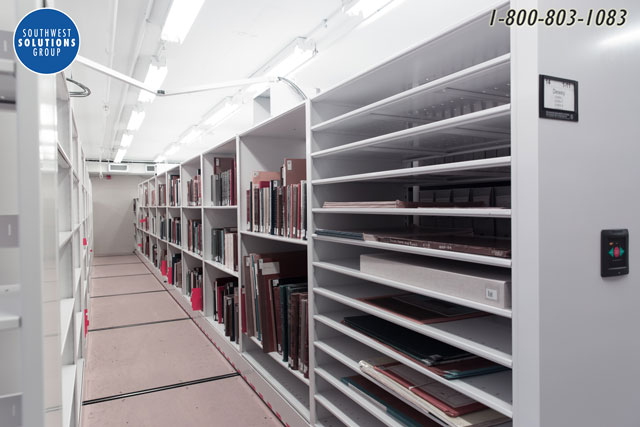
Common storage practices for works on paper include:
- Interleaving works on paper with acid-free tissue or acid-free paper when storing them together in drawers or boxes
- Matting works individually for better support and protection
- Enclosing works in acid-free folders (alkaline-buffered or neutral-pH folders recommended) or polyester film sleeves
- Storing interleaved, matted, or enclosed works on paper in acid-free archival or Solander boxes for further protection from light, dust, pollutants, and damage
Read on to learn about the best practices for storing works on paper and the different storage options available. You can also check out more of our museum storage solutions here.
Care and Storage of Works on Paper
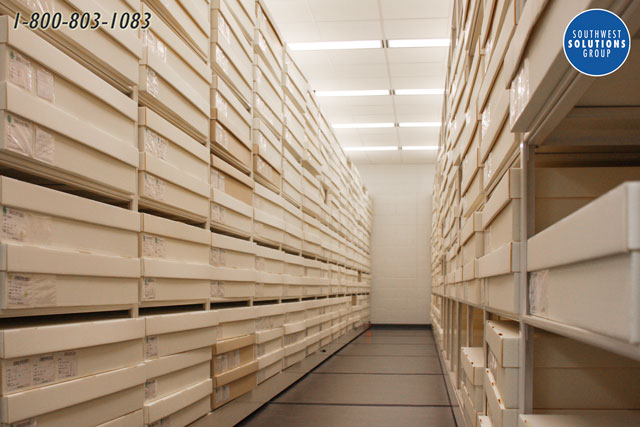
Works on paper are sensitive to environmental factors such as humidity, temperature, and light. When storing works on paper, it is essential to ensure that these works are kept in a stable environment and adequately protected from light, dust, insects, and rodents. Visit our online store to see our museum storage products.
An appropriate storage environment for works on paper should adhere to the following recommendations:
- Clean and free of dust
- A cool temperature (below 70°F)
- Low relative humidity (the Library of Congress recommends around 35% relative humidity)
- A stable environment with little risk of leaks or fluctuating temperatures (avoid attics, basements, or outside walls)
- Minimal exposure to light, with no direct light exposure
- Distanced from radiators and vents

Common storage practices for works on paper include:
- Interleaving works on paper with acid-free tissue or acid-free paper when storing them together in drawers or boxes
- Matting works individually for better support and protection
- Enclosing works in acid-free folders (alkaline-buffered or neutral-pH folders recommended) or polyester film sleeves
- Storing interleaved, matted, or enclosed works on paper in acid-free archival or Solander boxes for further protection from light, dust, pollutants, and damage
Read on to learn about the best practices for storing works on paper and the different storage options available. You can also check out more of our museum storage solutions here.
Care and Storage of Works on Paper
The term “works on paper” typically refers to works of art on paper (such as drawings, paintings, and prints), documents, manuscripts, posters, maps, and other unbound paper materials. It’s best to store these works flat rather than folded or rolled to avoid damage. Depending on the size and type of work, works on paper may be stored in archival boxes, Solander cases, or flat file drawers.
Works on paper are sensitive to environmental factors such as humidity, temperature, and light. When storing works on paper, it is essential to ensure that these works are kept in a stable environment and adequately protected from light, dust, insects, and rodents. Visit our online store to see our museum storage products.
An appropriate storage environment for works on paper should adhere to the following recommendations:
- Clean and free of dust
- A cool temperature (below 70°F)
- Low relative humidity (the Library of Congress recommends around 35% relative humidity)
- A stable environment with little risk of leaks or fluctuating temperatures (avoid attics, basements, or outside walls)
- Minimal exposure to light, with no direct light exposure
- Distanced from radiators and vents

Common storage practices for works on paper include:
- Interleaving works on paper with acid-free tissue or acid-free paper when storing them together in drawers or boxes
- Matting works individually for better support and protection
- Enclosing works in acid-free folders (alkaline-buffered or neutral-pH folders recommended) or polyester film sleeves
- Storing interleaved, matted, or enclosed works on paper in acid-free archival or Solander boxes for further protection from light, dust, pollutants, and damage
Read on to learn about the best practices for storing works on paper and the different storage options available. You can also check out more of our museum storage solutions here.
Works on Paper Storage Solutions
After taking these precautions, works on paper should be stored in sturdy, non-off-gassing shelving or cabinets. Some ideal, space-efficient storage solutions for works on paper are discussed below.
Works on Paper Shelving
Steel shelving is an excellent solution for horizontal works on paper storage. These space-efficient shelving units are ideal for storing Solander boxes and flat works.
The steel works on paper shelving feature a non-off-gassing powder-coated paint finish that meets archival and museum quality standards. The shelves are adjustable, allowing you to store boxes or works of different sizes efficiently. The shelving units are available in a wide selection of colors.
Standard shelving dimensions include:
- Widths: 30″, 36″, 42″, or 48″
- Depths: 24″, 30″ 36″, 48″, 60″, or 72″
- Heights: 76″, 88″, 97″
Custom sizes are available on request.
Flat File Cabinets
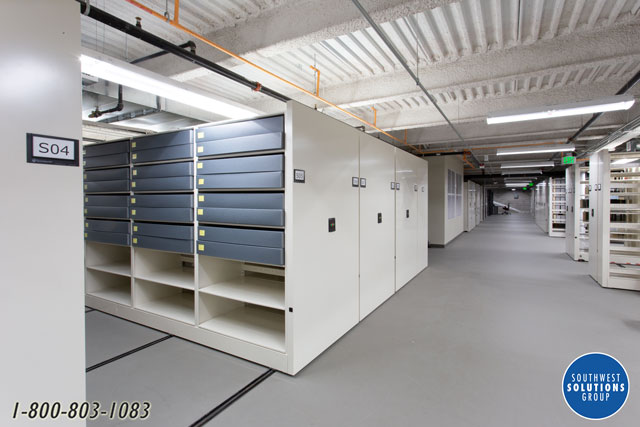
Flat file cabinets typically have four to six shallow drawers, perfect for storing individual or interleaved works, and the cabinets can be stacked two or three high. The cabinet’s top provides a convenient work surface or, with glass-top models, can be used to display works in the top drawer.
Like the standard shelving, flat file cabinets have a non-off-gassing powder-coat finish. Drawers roll smoothly on stainless steel tracks and plated rollers, with cushioned drawer bumpers and safety stops to prevent jolting. The drawers can also lock to prevent unauthorized access to stored works on paper. Read more about museum flat file cabinets here.
High-Density Mobile Shelving
If limited storage space is a concern, high-density mobile shelving could be your solution. These compact storage systems consist of shelving units mounted on mobile carriages that slide on floor tracks. This efficient storage system eliminates static aisle space to double your storage capacity in your existing footprint.
High-density storage systems can accommodate nearly any kind of shelving, including works on paper shelving and flat file cabinets. The system’s compact nature helps protect stored works on paper from dust, light exposure, and pests. Both manually operated and powered options are available. Learn more about high-density mobile shelving here.
Works on Paper Storage Solutions
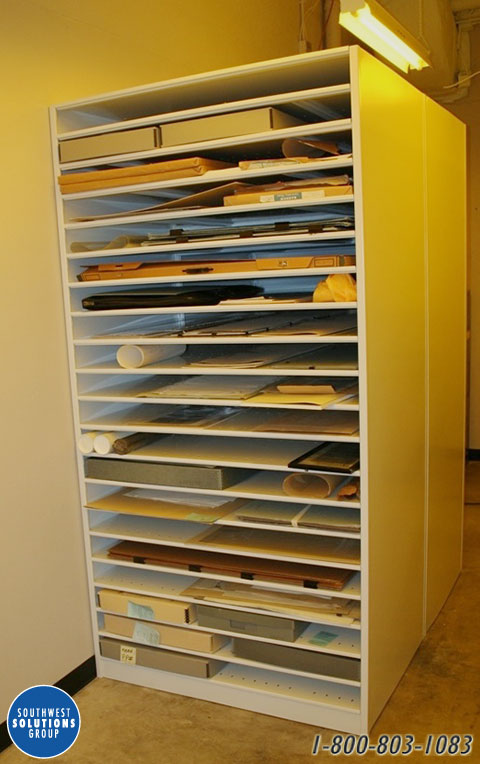
Works on Paper Shelving
Steel shelving is an excellent solution for horizontal works on paper storage. These space-efficient shelving units are ideal for storing Solander boxes and flat works.
The steel works on paper shelving feature a non-off-gassing powder-coated paint finish that meets archival and museum quality standards. The shelves are adjustable, allowing you to store boxes or works of different sizes efficiently. The shelving units are available in a wide selection of colors.
Standard shelving dimensions include:
- Widths: 30″, 36″, 42″, or 48″
- Depths: 24″, 30″ 36″, 48″, 60″, or 72″
- Heights: 76″, 88″, 97″
Custom sizes are available on request.
Flat File Cabinets

Flat file cabinets typically have four to six shallow drawers, perfect for storing individual or interleaved works, and the cabinets can be stacked two or three high. The cabinet’s top provides a convenient work surface or, with glass-top models, can be used to display works in the top drawer.
Like the standard shelving, flat file cabinets have a non-off-gassing powder-coat finish. Drawers roll smoothly on stainless steel tracks and plated rollers, with cushioned drawer bumpers and safety stops to prevent jolting. The drawers can also lock to prevent unauthorized access to stored works on paper. Read more about museum flat file cabinets here.
High-Density Mobile Shelving
If limited storage space is a concern, high-density mobile shelving could be your solution. These compact storage systems consist of shelving units mounted on mobile carriages that slide on floor tracks. This efficient storage system eliminates static aisle space to double your storage capacity in your existing footprint.
High-density storage systems can accommodate nearly any kind of shelving, including works on paper shelving and flat file cabinets. The system’s compact nature helps protect stored works on paper from dust, light exposure, and pests. Both manually operated and powered options are available. Learn more about high-density mobile shelving here.
Works on Paper Storage Solutions
After taking these precautions, works on paper should be stored in sturdy, non-off-gassing shelving or cabinets. Some ideal, space-efficient storage solutions for works on paper are discussed below.
Works on Paper Shelving
Steel shelving is an excellent solution for horizontal works on paper storage. These space-efficient shelving units are ideal for storing Solander boxes and flat works.
The steel works on paper shelving feature a non-off-gassing powder-coated paint finish that meets archival and museum quality standards. The shelves are adjustable, allowing you to store boxes or works of different sizes efficiently. The shelving units are available in a wide selection of colors.
Standard shelving dimensions include:
- Widths: 30″, 36″, 42″, or 48″
- Depths: 24″, 30″ 36″, 48″, 60″, or 72″
- Heights: 76″, 88″, 97″
Custom sizes are available on request.
Flat File Cabinets

Flat file cabinets typically have four to six shallow drawers, perfect for storing individual or interleaved works, and the cabinets can be stacked two or three high. The cabinet’s top provides a convenient work surface or, with glass-top models, can be used to display works in the top drawer.
Like the standard shelving, flat file cabinets have a non-off-gassing powder-coat finish. Drawers roll smoothly on stainless steel tracks and plated rollers, with cushioned drawer bumpers and safety stops to prevent jolting. The drawers can also lock to prevent unauthorized access to stored works on paper. Read more about museum flat file cabinets here.
High-Density Mobile Shelving
If limited storage space is a concern, high-density mobile shelving could be your solution. These compact storage systems consist of shelving units mounted on mobile carriages that slide on floor tracks. This efficient storage system eliminates static aisle space to double your storage capacity in your existing footprint.
High-density storage systems can accommodate nearly any kind of shelving, including works on paper shelving and flat file cabinets. The system’s compact nature helps protect stored works on paper from dust, light exposure, and pests. Both manually operated and powered options are available. Learn more about high-density mobile shelving here.
 See Museum Storage Solutions Prices
See Museum Storage Solutions Prices
See Museum storage shelving, racks, & cabinets prices
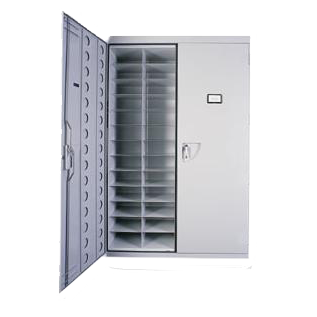
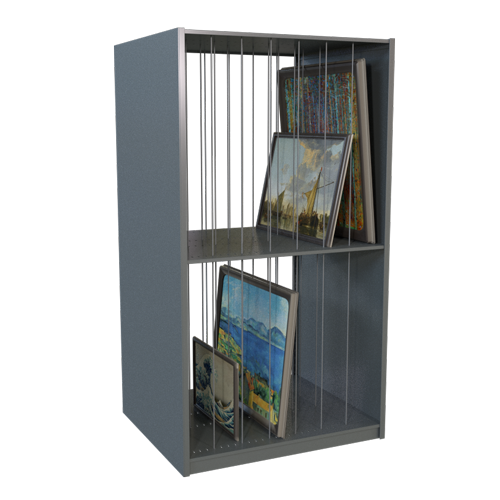
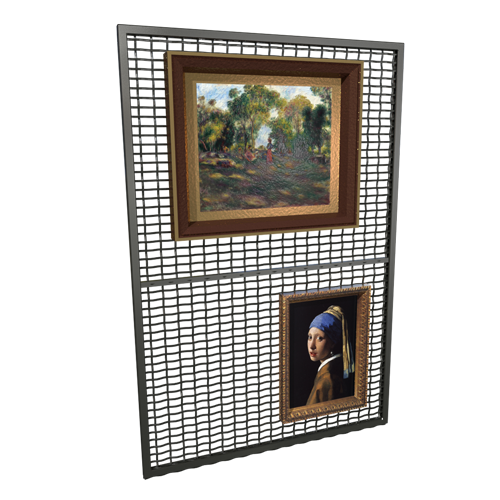
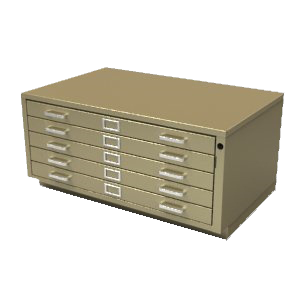
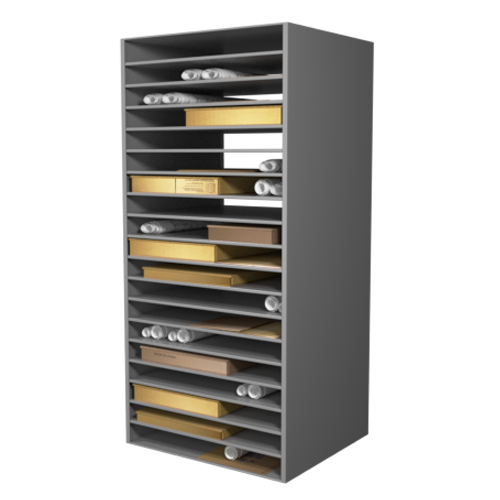
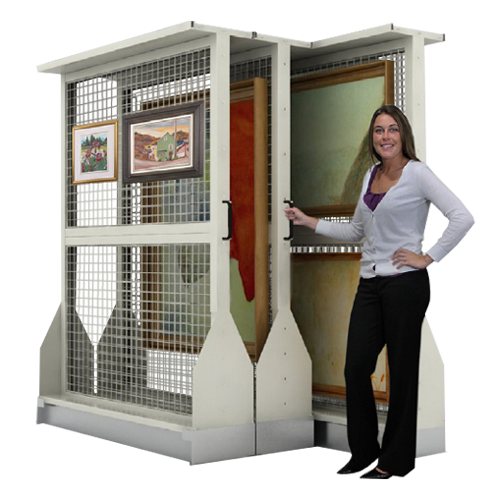
Contact Us for Works on Paper Storage
Southwest Solutions Group® provides design and installation services for works on paper storage for museums, archives, libraries, and other businesses. We will also provide a free consultation to determine your exact needs and specifications before the design begins. To learn more or to speak with a specialist, call us at 1-800-803-1083 or send us a message today.
Resources
Museum Testimonials

“I want to thank your entire team for the outstanding work on our art storage project. The process from beginning to end was smooth and enjoyable, and the finished room looks terrific! Chester, Bryan, Chris, Chris, and the other members were extremely thorough and a pleasure to work with. They followed our house rules and took our direction very well. Thanks again for an outstanding project, and I look forward to working with Southwest Solutions in the future should the opportunity arise. ”

“The new art racks are massive and beautiful! I cannot wait to hang art on the racks with those fancy hooks, wow! Thank you for helping me see the project through. The efforts of your team and installation really made the project go very smoothly and on time. We look forward to showing off the new and improved art storage room to our Director, Board Members, and Staff. Thanks a million, it has been a pleasure to work with you and your wonderful team on our paintings storage area.”
“I would like to thank you and your team at Southwest Solutions Group for working with the museum so diligently over the years. I also want to thank you personally for your patience, professionalism and great attitude as we’ve navigated the sometimes bumpy road to completing the Blanton Phase I and Phase II. Southwest Solutions Group will certainly be at the very top of my list for any future museum storage needs.”

“Southwest Solutions Group is an amazing company made so much better by having Daryl at the helm of Museum and Library storage space saving designs in the NW. Daryl is not only an expert in high density shelving systems, but he consistently tunes into optimizing long term solutions to complex storage needs and pliable projects. Always reliable and knowledgeable, Daryl and his Spacesaver’s team have been indispensable partners in our world of cultural preservation.”
See more museum testimonials


 Museum storage brochure overview
Museum storage brochure overview Museum Cabinets Storage Systems
Museum Cabinets Storage Systems Museum Collections Storage Guide
Museum Collections Storage Guide Museum Design Considerations
Museum Design Considerations Museum Preservation
Museum Preservation Risk Management in Museums
Risk Management in Museums